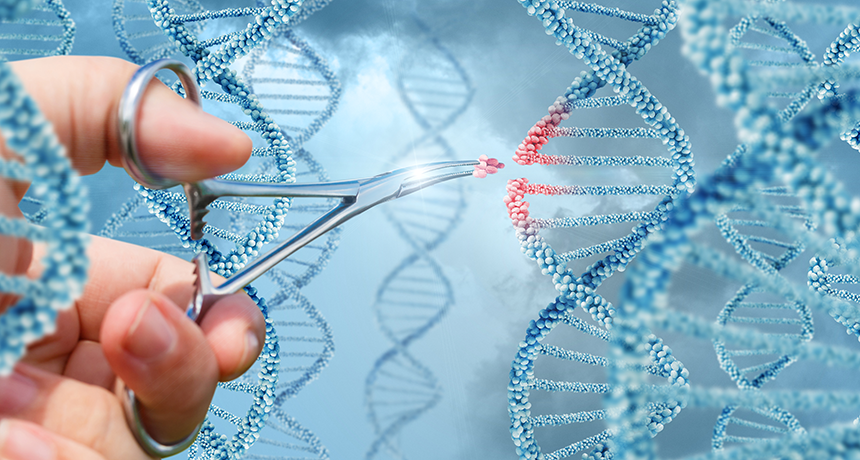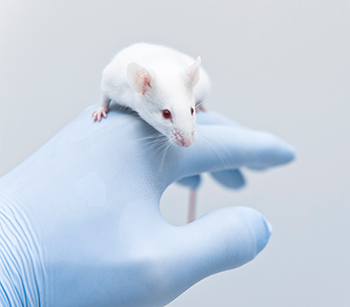Explainer: Why scientists sometimes ‘knock out’ genes
This technique can help researchers probe the role of a single gene

Scientists don’t really use a forceps when tweaking our DNA. But they do have techniques that allow them to snip out (or turn off) genes in an organism. Afterward, they can investigate the gene’s function by noting what happens when it’s lost.
Natali_Mis/iStockphoto
Each human cell contains some 20,500 different genes. These are small bits of DNA that instruct a cell on what it should do. How do scientists uncover a particular gene’s instructions? One way is to observe how a cell (or a whole organism) behaves when that single gene is absent, or at least not working. Scientists can do that by disabling — or knocking out — a desired gene.
No boxing gloves are required. All they need to start is a single cell. That cell can be a bacterium or yeast. Or it can come from an embryo — the very earliest stages of a developing animal or plant.
The goal of each gene is to make a protein. Proteins are molecules made of long chains. They are the building blocks of most things in our bodies — from bones to muscles to brain. Our bodies make more proteins all the time. But to build them, they have to go back and read the instruction manual — the DNA. Each gene in our DNA produces a different protein.
Often, however, scientists don’t know which gene produces which protein. To find out, scientists can start by knocking out the gene they are interested in. Watching for which protein — or which protein effect — is now gone points to the role of the protein’s maker, or gene.
To knock out the gene, scientists first find or create a version of the gene that doesn’t work. These often will be genes with some serious mistake, or mutation. That mistake makes the gene a total dud — it can’t possibly help produce a protein. They insert this unworking gene into the DNA of a healthy cell. Often, scientists will first attach a “tag” to the dud. Called a reporter gene, that tag can alert scientists when the new gene has been successfully accepted by the cell. How? Reporter genes often produce proteins that glow in green or blue. This lets scientists scout for cells with a tell-tale glow.
How the dud gene becomes part of a new cell
DNA is composed of long strands of genes. It also has sequences of genetic material that play other roles. But sometimes these long strands of DNA become damaged or break. Luckily, machinery within our cells can fix it. Scientists can use that cellular toolbox to slip their knockout gene into the DNA.
The DNA surrounding the gene the scientists want to replace can act like a disguise and helps sneak the dud gene in. When scientists insert their dud gene into a cell, they make sure it has perfect copies of the DNA surrounding the gene that they want to replace. This DNA-costume can fool the DNA-repair system strands. When that system sees the guide DNA, it gets tricked into swapping the dud gene in for the old healthy gene. This “knocks out” the original gene.
Sometimes scientists do not need to perform a full swap. Or they may not know precisely where they need to place the new DNA segment. In these cases, they can insert the reporter gene randomly into the DNA they want to get rid of. Instead of swapping out the old gene, the reporter gene simply gets wedged into the middle of it. When the cell goes to read the gene, the new piece of DNA crammed inside means that the original gene’s instructions no longer makes any sense to the cell. The cell can no longer use this gene to make a protein.
Once a cell is now missing some selected gene, scientists watch what happens. If the cell is a bacterium or yeast, scientists will observe whether it works differently. If the cell is in an embryo, scientists can see how the animal or plant that grows from it differs from normal.
When or where to knock out a gene
Some genes must be working before an embryo can grow into an adult. If scientists want to study this gene, they likely will have to wait until the animal is an adult before they knock out such a gene. Or they may want to see what happens when a gene stops functioning in just one part of the body. Or at some specific time as the cell or animal grows. In these cases, scientists may create something called a conditional knockout.

To make a conditional knockout mouse (for example), scientists start with the single cell and insert short portions of DNA on either side of the gene they want to knock out. At first, those added DNA sequences don’t change anything about how the cell operates. That means the cell can develop into an adult mouse.
When grown, this mouse now can mate with another adult that has an inserted gene for a protein called Cre recombinase (CREE Ree-KOM-bih-nase), or CR. This gene comes from a virus that usually infects bacteria. The offspring of the two mutant animals will get both added genes, one from each parent. In the pups’ cells, the CR protein recognizes the short DNA sequences surrounding the targeted gene. Then the CR protein can turn that gene on, turn it off, or switch it out for another gene entirely.
But the CR protein doesn’t automatically go to work. In fact, scientists don’t want it to. They want to select precisely when CR turns on.
The gene that makes CR is controlled by yet another gene, a promoter. Something must trigger the promoter in order for a cell to make the CR protein. Usually, some specific drug serves as the trigger. Scientists sometimes use tamoxifen — a drug used to treat breast cancer. Other times they may use an antibiotic drug as the trigger.
Scientists apply the drug to a cell, or give it to an animal in its food. The drug triggers the promotor, and Cre recombinase is made. This protein then knocks out the gene of interest.
Using these various techniques, researchers now can knock out the genes of any organism they choose. There are plants, bacteria and mice with knocked out genes. Scientists can even knock out the genes of human cells growing in a lab.







